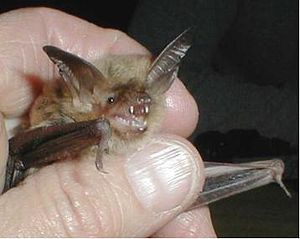North American fringed bat
| North American fringed bat | ||||||||||||
|---|---|---|---|---|---|---|---|---|---|---|---|---|

North American fringed bat ( Myotis thysanodes ) |
||||||||||||
| Systematics | ||||||||||||
|
||||||||||||
| Scientific name | ||||||||||||
| Myotis thysanodes | ||||||||||||
| Miller , 1897 |
The North American fringed bat ( Myotis thysanodes ) is a bat species from the smooth-nosed family (Vespertilionidae), which is native to North America.
description
The North American fringed bat is a long-eared mouse -eared bat and is the only species of this genus to have a row of stubble hairs on the edge of the tail membrane . The species looks similar to the northern long-eared mouse-eared mouse ( Myotis evotis | M. Evotis ), but is slightly larger than this. The head-torso length is 43–59 mm, the tail is 34–45 mm long and the forearm length is 40–47 mm, the females being slightly larger than the males ( sexual dimorphism ). The fur is yellowish-brown to olive-brown, with the belly only slightly lighter than the back. The northern populations appear to be a bit darker than the southern ones.
Way of life
The North American fringed bat , like most bats, is nocturnal and feeds on insects, with beetles being preferred. The bats fly relatively slowly and agile, mostly on the edge of the forest, looking for food. The measured airspeed is about 14 km / h. The animals spend the day in caves, mines and buildings, returning to these hiding spots during the night between their foraging flights. The species is one of the migratory bat species in North America. In winter, the animals migrate to the southern regions of their range and hibernate there between September and April .
Reproduction
The North American fringed bat mates in the fall. The females store the sperm through the winter; the ovulation and subsequent fertilization of the egg takes place after hibernation in April or May. After a gestation period of 50 to 60 days, the females give birth to a single young. The newborns are already half the size of the adult animals. The eyes are open, the skin color pink until about a week of age when the pigmentation develops. The nursery is separated from the hanging place for the adult animals. It was observed how the mother animals regularly fly to their young, suckle it and then hang back to the other females. Young animals that fall down are approached by the adult animals so that the young can suck on the teats and be flown back to the hanging place. After 16 days the cubs make their first attempts to fly independently, and after 21 days they cannot be distinguished from the adult without closer inspection.
distribution and habitat
The North American fringed bat occurs in the United States from the west coast to Nebraska , South Dakota and Texas in the east, as well as in Mexico and southern British Columbia ( Canada ). The species prefers a variety of landscape types, ranging from desert-like regions to fir - pine forests, and it is often found in forests with oak and pinyon-pine associations. Their population is classified as safe by the IUCN .
literature
- MJ O'farrell & EH Studier (1980): Myotis thysanodes . In: Mammalian Species , No. 137, pp. 1-5
